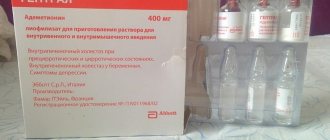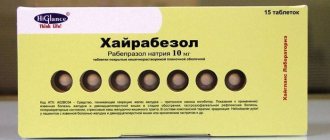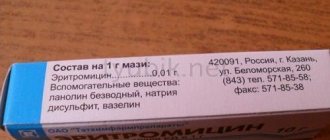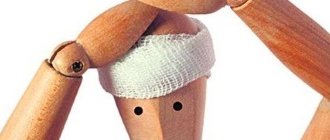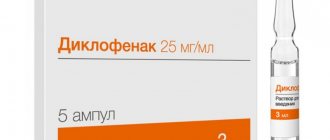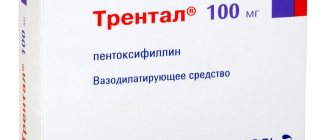It happens that pain in the joints, spine or neck constrains the body so that it is impossible to sit down, stand up or move any member. Many people are probably familiar with this situation. Of the numerous existing medications, I would like to find one that will instantly relieve pain and restore mobility to our body.
Very often, a drug prescribed by a doctor or purchased at a pharmacy turns out to be powerless in such cases. Then we turn to the worldwide Internet - our lifesaver in many situations, including in search of a remedy that actually works and will help us find, if not health, but at least relief. The drug Ortofen, which is based on the well-known diclofenac, is a panacea in cases of unbearable pain that arises suddenly.
Effect of the drug
Ortofen is a non-steroidal anti-inflammatory drug that acts instantly, relieving not only terrible pain, but also eliminating the source of inflammation. The medicine has powerful anti-inflammatory, antipyretic and analgesic effects and quickly, in just a few minutes, relieves us of unpleasant symptoms that can drive us crazy.
Due to its rapid penetration into the gastrointestinal tract, the drug is widely used in the treatment of acute cases of musculoskeletal diseases.
It is able to relieve spontaneous pain syndrome in a short time, as well as eliminate pain when moving, and relieve swelling of the affected area. The product brings relief from painful menstruation, injuries, toothache and other cases.
After oral administration, the medicine is quickly absorbed into the gastrointestinal tract. Consumption along with food slows down the absorption process, but does not affect the concentration of the drug in the blood. About 60% of Ortofen is excreted through the kidneys, 1% is excreted unchanged in the urine, and the rest of the drug is excreted in bile.
Pharmacological properties
According to its purpose, Ortofen is defined as a derivative of phenylacetic acid. It is usually classified as a non-steroidal anti-inflammatory drug.
Its pharmacological effect on the body is determined as follows:
- rapid elimination of the source of inflammation and reduction of the patient’s body temperature;
- relief of the inflammatory process;
- reducing swelling of the soft tissues of the patient’s body;
- antiallergic effect, desensitizing type;
- inhibition of proteoglycan production in the patient's bones;
- Elimination of pain on the surface of the skin and deep in the tissues of the body.
The described pharmacological action of the drug is based on the principle of suppressing the activity of prostaglandin synthesis.
These enzyme components are directly involved in the process of growth and formation of the inflammatory process, which is caused by microbial and infectious microflora.
Release forms and composition
The drug Ortofen is available in several forms: 25 mg tablets, coated with a yellow coating (the cardboard package contains one, two or three blisters with pills sealed in them); in the form of a solution for injection, 3 and 5 ml in an ampoule (packed with 5 or 10 ampoules); in the form of rectal suppositories 50 and 100 mg (10 pieces in a cardboard box); in the form of ointments and gels, 30 or 50 g in tubes.
One tablet contains diclofenac sodium 25 mg. The drug also consists of excipients:
Potato starch;- Povidone;
- Cellactose;
- Microcrystalline cellulose;
- Calcium stearate;
- Sodium starch glycolate;
- Titanium dioxide;
- Talc;
- Yellow dye.
One ampoule of solution for intramuscular injection of 3 or 5 ml contains 1 ml of diclofenac sodium 25 mg and water for injection.
Ortofen gel consists of:
- Diclofenac sodium - 5 g;
- Propylene glycol - 5 g;
- Ethanol - 30 g;
- Hyaetelloses - 2.5 g;
- Purified water - 100 g.
The ointment contains:
- Diclofenac sodium - 2.5 g;
- Benzyl benzoate - 6 g;
- Polysorbate - 1 g;
- Nipagina - 0.08 g;
- Nipazole - 0.02 g;
- Carbomer 940 - 0.75 g;
- Trolamina - 0.4 g;
- Purified water - 100 ml.
Rectal suppositories consist of:
- Diclofenac - 50 or 100 mg;
- Propylene glycol;
- Aerosil;
- Witepsola;
- Solid fat;
- White dye.
Indications
The drug has a fairly wide spectrum of action. It is used both for joint pain and for injuries, bruises and many other diseases. Ortofen is prescribed by a doctor in the following cases:
- Acute rheumatism;
- Radiculitis;
- Sciatica;
- Lumbago;
- Osteochondrosis;
- Arthritis and arthrosis;
- Neuralgia;
- Myositis;
- Headache and toothache;
- Painful menstruation;
- Inflammation of the appendages;
- Degenerative joint diseases;
- Tendon and ligament sprains, bruises and other closed injuries, etc.
The medicine is successfully used in the complex treatment of ENT diseases, such as tonsillitis, otitis media, pharyngitis, etc. For different severity of pathology, different forms of the drug are used.
What do Ortofen tablets help with? They are mainly used in the treatment of:
- Inflammatory joint diseases;
- Osteoarthrosis;
- Rheumatism and rheumatoid arthritis.
Ortofen injections are used in more complex cases, for example, if there is:
- Fever syndrome;
- Severe ENT diseases - diseases complicated by the inflammatory process;
- Renal colic;
- Abdominal pain;
- Migraine;
- Gouty arthritis;
- Acute radiculitis;
- Lumbago, sciatica, etc.
Ointments and gels are used topically for bruises, injuries, joint diseases (arthritis, arthrosis, inflammatory swelling of tissues during high physical activity, etc.)
Indications for use
Ortofen ointment is prescribed to patients who have been diagnosed with dystrophic-degenerative pathologies of the joints and various parts of the spinal column. The drug is used only to eliminate the clinical manifestations of diseases, since it does not have the ability to influence their cause and developed consequences. The use of Ortofen ointment is relevant for the treatment of such pathologies:
- neuralgic conditions: sciatica, lumbago;
- diseases of the musculoskeletal system: osteoarthritis of the spinal column and joints, ankylosing spondylitis, rheumatic soft tissue lesions, chronic juvenile, gouty, rheumatoid, psoriatic arthritis;
- inflammatory process occurring against the background of post-traumatic pain syndrome;
- post-traumatic inflammation of the musculoskeletal system and soft tissues;
- postoperative pain syndrome;
- tendovaginitis, ankylosing spondylitis, bursitis, sciatica, dorsalgia of various origins, myalgia;
- arthralgia, ossalgia, radiculitis, osteochondrosis of the back with any localization.
Even a single application of ointment to the area of swelling and inflammation can quickly reduce the intensity of pain from dislocations, bruises, sprains, and ligament damage. Such injuries are always accompanied by rapidly forming hematomas. The active ingredient of the external agent restores microcirculation in damaged soft tissues, stimulates their blood supply with molecular oxygen and nutrients. This initiates rapid resorption of edema and hematomas.
Several years ago, clinical trials were conducted in which 6,000 patients with various diseases of the musculoskeletal system took part - dorsalgia, radiculalgia, rheumatic lesions of soft tissues. After regular use of external preparations with diclofenac, by the 3rd day of therapy, intense pain remained in only 500 people, and on the 8th day of treatment, 81% of the patient had only minor discomfort.
Contraindications
According to the instructions for use, Ortofen cannot be used for:
- Having an allergy to the components of the drug;
- Gastrointestinal diseases (stomach and duodenal ulcers);
- Bleeding from the gastrointestinal tract;
- Inflammatory bowel diseases;
- Severe pathologies of the liver and kidneys;
- Severe heart failure.
The ointment and gel are not applied to open wounds, as well as to those areas of the skin that have abrasions, scratches and microcracks.
Ortofen preparations are not used to treat children under 6 years of age. During pregnancy and lactation, the medicine is used only in cases where it is vitally necessary. Therapy is carried out under the strict supervision of a doctor.
Contraindications for use
Ortofen ointment is not used for therapy if an individual predisposition to the occurrence of a sensitization reaction to the active ingredient or base-forming substances has been identified. The drug is prohibited for use if there is a history of bronchial asthma attacks that occurred after taking salicylates (including acetylsalicylic acid) and non-steroidal anti-inflammatory drugs containing ibuprofen, ketoprofen, meloxicam, nimesulide. Absolute contraindications for Ortofen ointment include:
- children under 6 years of age;
- ulcerative lesions of the digestive tract;
- gastritis occurring against the background of a violation of the integrity of the gastric mucosa;
- 3rd trimester of pregnancy.
In the later stages of pregnancy, the use of the drug weakens labor. Due to the ability of the active ingredient to penetrate any biological barrier, placental circulation may be disrupted. Ortofen ointment can be used in the 1st and 2nd trimesters of pregnancy under medical supervision and in adjusted dosages. Before including a drug in a therapeutic regimen, the doctor weighs the risk for the child and the benefit for the mother.
As a result of a study on animals, the teratogenic effect of diclofenac was not revealed. The nonsteroidal anti-inflammatory drug did not have any effect on fetal development.
Side effects
The use of Ortofen in some cases may be accompanied by side effects such as:
- Stool disorders, nausea and vomiting, bloating, flatulence, discomfort in the epigastrium;
- Bleeding and erosion, as well as ulcers;
- Liver dysfunction;
- Anemia, leukopenia, agranulocytosis, thrombocytopenia;
- Head pain, dizziness, increased blood pressure, agitation, sleep disturbances, loss of strength, irritability, mental disorders, ringing in the ears, depression, apathy, diplopia, convulsions, tremor;
- Renal dysfunction and edema;
- Allergic manifestations - itching, swelling, urticaria, peeling;
- When administering injections, there is a burning sensation, the appearance of an abscess at the injection site;
- When using ointments and gels - allergic reactions.
Side effects
From the gastrointestinal tract
: nausea, vomiting, stool disorders, flatulence. In rare cases, rectal irritation, vomiting with blood, hemorrhagic diarrhea, esophageal disorders, colitis, pancreatitis, melena, gastrointestinal ulcer;
From the side of the central nervous system:
dizziness, headache, tinnitus, sleep disturbances, nightmares, increased fatigue, depression, tinnitus, psychotic disorders, perversion of taste;
From the cardiovascular system
: development of edema, blood pressure lability, heart failure, arterial hypertension;
From the immune system:
hypersensitivity, anaphylactic reactions, angioedema.
From the hepatobiliary system
: increased liver enzymes, impaired liver function, jaundice, liver failure;
From the urinary system
: in case of renal dysfunction, oliguria, cystitis, nephrotic syndrome, interstitial nephritis, medullary necrosis of the kidney;
From the skin:
allergic reactions, urticaria, Quincke's edema, Lyell's syndrome, Steven-Johnson syndrome, bronchospasm, anaphylaxis, exoliative dermatitis, toxic epidermal necrolysis;
From the respiratory system
: dyspnea, pneumonitis;
From the hematopoietic system:
anemia (hemolytic and aplastic), leukopenia, thrombocytopenia, pancytopenia, agranulocytosis
Overdose
An overdose of Ortofen can manifest itself:
- Nausea and vomiting;
- Gastrointestinal bleeding;
- A sharp decrease in blood pressure;
- Dizziness and fainting;
- Diarrhea;
- Cramps;
- Ringing in the ears;
- Damage to the liver and kidneys;
- Acute heart failure;
- Difficulty breathing.
At the first signs of diclofenac poisoning, you must immediately call an ambulance
special instructions
When using other analgesics, consult a doctor before using Ortofen.
This drug contains sugar, which should be taken into account when treating patients with diabetes.
The drug is allowed to be used in the first and second trimester of pregnancy only if the expected benefit to the mother's health outweighs the potential risk to the fetus. Diclofenac is not recommended for use in women planning pregnancy, as it has a negative effect on fertility.
Elderly patients and persons with impaired liver and kidney function should take Ortofen with extreme caution.
The drug may have a negative effect on the ability to drive vehicles or perform work that requires increased concentration and speed of psychomotor reactions. Therefore, it is recommended to refrain from such actions while taking it.
Instructions for use
The tableted drug is used 30 minutes before meals with a small amount of water. The usual dose for an adult is 25-50 mg in two or three divided doses, but not more than 150 mg per day. If a person has gastrointestinal diseases, then take the tablet on a full stomach.
Children from 6 to 18 years old are prescribed 25 mg per day once.
In special cases, the dosage is determined by the attending physician, depending on the diagnosis and the severity of the pathology.
Ortofen injections are prescribed once a day. Sometimes, for severe illnesses, the doctor prescribes injections twice a day. The daily dose of the medicine should not exceed 150 ml. Before administering the drug intramuscularly, the contents of the ampoule are diluted with a 0.9% sodium chloride solution or a 5% dextrose solution. The injection is placed in the upper right part of the right buttock or in the upper left part of the left, after generously wiping the injection site with medical alcohol. Treatment with the drug is carried out for no more than 2 weeks.
Ointment and gel 2-3 g are applied directly to the sore spot in a thin layer, continuously massaging for several minutes. Use the product no more than 4 times a day. The course of therapy is no more than two weeks.
Suppositories are administered strictly after a cleansing enema. The dosage is 100 mg once a day or 50 mg twice a day.
Dosage
The dosage of the medicine is determined by the instructions for use and the specific type of production, as well as the instructions of the attending physician.
Tablets are taken individually, one of them is taken half an hour before or during meals, the daily dose for a child does not exceed three tablets.
Creams and ointments of medication should be taken in doses, no more than 10 milligrams per application.
Increases in dosage are determined solely in consultation with the treating pediatrician.
Special Recommendations
For those patients who are allergic to diclofenac, treatment with the drug is prescribed only in particularly severe cases. At the same time, constant monitoring of the state of the kidneys and liver is carried out, and the composition of the blood is monitored.
Ortofen is not used simultaneously with drinking alcohol, as problems with the functioning of the heart, kidneys, liver, changes in blood pressure, fatigue, impaired coordination of movements and general intoxication of the body may occur.
Constant monitoring of renal function is necessary in elderly patients taking diuretics and simultaneously undergoing therapy with Ortofen.
For those women who are planning to become pregnant, it is better to refrain from using the drug.
Avoid getting the ointment or gel on the mucous membranes of the eyes and body.
When treating with the drug, it is necessary to stop driving vehicles, since at the time of taking Ortofen, the speed of the psychomotor reaction decreases
Ortophen
Gastrointestinal lesions
When using diclofenac, like other NSAIDs, phenomena such as bleeding or ulceration/perforation of the gastrointestinal tract, in some cases with fatal outcome, were observed. These events may occur at any time when using these drugs with or without previous symptoms or a history of serious gastrointestinal disease.
In older patients, such complications can have serious consequences. If bleeding or gastrointestinal ulceration develops in patients receiving Ortofen, the drug should be discontinued.
To reduce the risk of developing toxic effects on the gastrointestinal tract in patients with ulcerative lesions of the gastrointestinal tract, especially those complicated by bleeding or perforation in history, as well as in elderly patients, it should be used in the minimum effective dose.
In patients with an increased risk of developing gastrointestinal complications, as well as in patients receiving therapy with low doses of acetylsalicylic acid, gastroprotectors (proton pump inhibitors or misoprostol) or other medications should be taken during drug therapy to reduce the risk of undesirable effects on the gastrointestinal tract.
Patients with a history of gastrointestinal lesions, especially the elderly, should report all abdominal symptoms to the doctor.
Patients with bronchial asthma
Exacerbation of asthma (NSAID intolerance/NSAID-induced asthma), angioedema and urticaria are most often observed in patients with bronchial asthma, seasonal allergic rhinitis, nasal polyps, chronic obstructive pulmonary disease or chronic infectious diseases of the respiratory tract (especially those associated with allergic rhinitis). rhinitis-like symptoms). In this group of patients, as well as in patients with allergies to other drugs (skin rash and itching or urticaria), special caution should be observed when using the drug Ortofen (preparedness for resuscitation measures).
Skin reactions
Serious dermatological reactions such as exfoliative dermatitis, Stevens-Johnson syndrome, toxic epidermal necrolysis, in some cases fatal, have been reported very rarely with the use of diclofenac. The highest risk and incidence of severe dermatological reactions were observed in the first month of treatment with diclofenac. If a patient receiving Ortofen develops the first signs of a skin rash, lesions of the mucous membranes or other symptoms of hypersensitivity, the drug should be discontinued.
In rare cases, when using Ortofen, like other NSAIDs, anaphylactic/anaphylactoid reactions may develop in patients who have not previously received diclofenac.
Effects on the liver
Since during the period of use of the drug Ortofen, an increase in the activity of one or more “liver” enzymes may be observed, monitoring of liver function is indicated as a precautionary measure during long-term therapy with the drug. If liver dysfunction persists or progresses or signs of liver disease or other symptoms occur (for example, eosinophilia, rash, etc.), the drug should be discontinued. It should be borne in mind that hepatitis during the use of the drug Ortofen can develop without prodromal phenomena.
Effects on the kidneys
During drug therapy, it is recommended to monitor renal function in patients with hypertension, impaired cardiac or renal function, elderly patients, patients taking diuretics or other drugs that affect renal function, as well as in patients with a significant decrease in the volume of extracellular fluid of any etiology, for example, in the period before and after major surgical interventions. After cessation of drug therapy, normalization of renal function indicators to initial values is usually observed.
Effects on the cardiovascular system
Therapy with NSAIDs, including diclofenac, particularly long-term and high-dose therapy, may be associated with a small increased risk of serious cardiovascular thrombotic events (including myocardial infarction and stroke).
In patients with diseases of the cardiovascular system and a high risk of developing diseases of the cardiovascular system (for example, with arterial hypertension, hyperlipidemia, diabetes mellitus, smokers), the drug should be used with extreme caution, at the lowest effective dose for the shortest possible duration of treatment, since the risk of thrombotic complications increases with increasing dose and duration of treatment.
With long-term therapy (more than 4 weeks), the daily dose of diclofenac in such patients should not exceed 100 mg. The effectiveness of treatment and the patient's need for symptomatic therapy should be periodically assessed, especially in cases where its duration is more than 4 weeks. When the first symptoms of thrombotic disorders appear (for example, chest pain, feeling short of breath, weakness, speech impairment), the patient should immediately seek medical help.
Impact on the hematopoietic system
The drug may temporarily inhibit platelet aggregation, therefore, in patients with hemostasis disorders, it is necessary to carefully monitor relevant laboratory parameters.
With long-term use of the drug Ortofen, it is recommended to conduct regular clinical tests of peripheral blood.
Masking signs of an infectious process
The anti-inflammatory effect of the drug Ortofen may complicate the diagnosis of infectious processes.
Use simultaneously with other NSAIDs
The drug should not be used concomitantly with other NSAIDs, including selective COX-2 inhibitors due to the risk of adverse events.
Drug interactions
The drug should not be used simultaneously with:
- Antihypertensive drugs, the effect of which is weakened when using Ortofen;
- Potassium-sparing diuretics. When used together with medication, the concentration of potassium in the blood increases;
- Glucocorticosteroids, as side effects from the gastrointestinal tract are possible;
- Hypoglycemic agents, the simultaneous use of which with Ortofen may cause hyperglycemia or hypoglycemia in people with diabetes;
- Aspirin, which reduces the concentration of diclofenac in the blood;
- Ceftriaxone, which can accumulate in bile when used together with Ortofen;
- Cyclosporine. As a result of its simultaneous use with Ortofen, severe kidney damage may occur;
- Morphine due to the possible risk of respiratory depression.
The use of Ortofen with other non-steroidal anti-inflammatory drugs increases the risk of side effects.
Before starting treatment with Ortofen, you must carefully read the instructions for use of the drug.
Pharmacokinetics
Local application ensures partial gradual absorption of the active substance, amounting to about 6%. The advantages of the drug include the creation of a higher concentration of diclofenac sodium in the synovial fluid than in the systemic circulation. 99% of the active ingredient binds to serum proteins albumin. The half-life is 3-6 hours . The maximum therapeutic concentration is detected in the inflammatory focus after approximately 2-3 hours.
Diclofenac is metabolized by hepatocytes by glucuronidation of unchanged molecules or by single or multiple hydroxylation and methoxylation. As a result of biochemical reactions, phenolic metabolites are formed, most of which are transformed into glucuronide conjugates. Two of them are characterized by biological activity similar to non-transformed diclofenac. Studies have revealed that active metabolites remain in the human body longer.
More than 60% of the active ingredient of Ortofen ointment is evacuated by the urinary system in the form of glucoronic conjugates of metabolites or unchanged NSAIDs. 40% of the active ingredient is excreted along with bile acids during bowel movements.
Prices
The table shows prices for Ortofen drugs available in online pharmacies
| Name of the drug | Manufacturer | price, rub. |
| Ortofen – 2.5%, solution for injection, 3 ml – 10 ampoules | Moskhimfarmpreparaty, Russia | 42 |
| Ortofen – 5%, 50.0 – gel | Vertex | 179 |
| Ortofen – 2%, 50.0 – ointment | Vertex | 129 |
| Ortofen – 2%, 30.0 – ointment | Vertex | 107 |
| Ortofen – 0.025, 20 tablets | Tatkhimpharmaceuticals | 51 |
Prices for drugs in different pharmacies may vary slightly.
Analogs
There are a great many analogues of Otofen, since the active substance diclofenac is very popular in the treatment of many diseases. The most popular analogues of the drug are:
- Diclofenac 0.05 - 20 tablets - 39 rubles;
- Diclofenac 5% gel 50.0 - 128 rub.;
- Diclofenac 2% ointment 30.0 - 39 rubles;
- Diclofenac 0.05 rectal suppositories 10 pieces - 57 rubles;
- Diclofenac 0.025 in ampoules of 3 ml 5 pieces - 61 rubles;
- Voltaren emulgel 2% 150.0 - 665 rub.;
- Voltaren emulgel 2% 50.0 - 499 rub.;
- Voltaren 0.05 rectal suppositories 10 pieces - 372 rubles;
- Voltaren 0.1 rectal suppositories 5 pieces - 321 rub.;
- Voltaren 0.05 - 20 tablets - 283 rubles;
- Voltaren 0.025 - 5 ampoules of 3 ml - 276 rubles;
- Diklak 5% gel 100.0 - 367 rub.;
- Diklak 5% gel 50.0 - 278 rub.;
- Diclovit 0.05 rectal suppositories 10 pieces - 169 rubles;
- Diclovit 1% gel 20.0 - 160 rub.;
- Naklofen Duo 0.075 - 20 capsules - 126 rubles;
- Diclonate P 0.075 - 5 ampoules of 2 ml - 104 rub.
Reviews
Reviews of Ortofen drugs are generally positive. The medicine works in almost all cases, however, patients note some side effects, in particular, the negative effect of diclofenac on the stomach when taking tablets
Irina, 38 years old, Nizhny Novgorod “Some time ago I was struck by radiculitis. She sat down in a chair, but could no longer get up. I called the doctor to the house. He prescribed me Ortofen in injections and tablets. After two injections, relief came, the pain went away, and I was able to move more freely. I took injections for five days, and for another five days I had to take pills. After several tablets, my stomach ached severely, chronic gastritis worsened, but there was no trace of radiculitis left. The drug helped me, but there was an unpleasant aftertaste after treatment as a side effect.”
Agrippina, 44 years old, Leningrad region. “We live in a village. In the summer, while digging in the beds, my mother felt unbearable pain in her hip joint. Old arthritis took its toll. The paramedic advised us to take a course of Dilofenac, which we bought at a local pharmacy. We were given a choice of two medications - Ortofen and Diclofenac. Both have the same active ingredient, but the difference is in price. Ortofen turned out to be much cheaper. We decided to take a chance and bought this particular product. We needed 10 ampoules for the course of treatment. After the first injection, the pain subsided so much that my mother was able to move again, and after the third injection she was ready to run, however, we nevertheless completed the course of treatment. A good product, we recommend it!”
Nadezhda, 27 years old, Kazan “Several years ago, during an aerobics class, I fell and sprained my leg near the knee. The leg was very swollen. There was unbearable pain when walking. Since I had the opportunity to rest at home, I did not go to the doctor, but after a while the injury made itself felt. In winter, while climbing the stairs, I felt that my knee was “crunching”. I was very scared and ran to the doctor, who diagnosed tenosynovitis. The traumatologist prescribed me Ortofen tablets. After taking the pills for several days, I felt slightly nauseous, but the crunch in my knee and the pain went away. I stopped taking pills, but that’s not all. When the weather changes, my knee starts to ache so much that I can’t sleep. My husband found an alternative to pills and bought 2% Ortofen ointment at the pharmacy, which saves me to this day from exacerbations of my disease. Very pleased with the product. At an affordable price - maximum efficiency."
Results
From all of the above, we can draw the following conclusion - Ortofen helps with many problems of the musculoskeletal system and more. Even the presence of some side effects cannot lower the rating of the drug among the population, because if tablets are not suitable, they can be freely replaced with injections or, if necessary, with an ointment or gel.
Preparations based on diclofenac, in particular Ortofen, are very popular among a huge number of patients due to their effectiveness - in a very short time the drug, relieving pain and inflammation, literally puts them on their feet. Doctors recommend having Ortofen in individual first aid kits as an “ambulance” to relieve pain of various etiologies.
Pharmacodynamics
A derivative of phenylacetic acid is able to block inflammatory processes affecting the synovial membrane of joints and extra-articular synovial structures. Diclofenac sodium reduces the production of prostaglandins E2 by subacromial bursa cells in patients with subacromial impingement syndrome of the shoulder and other joints. After applying Ortofen ointment to the area of pain, the migration of leukocytes to inflammatory foci is inhibited, since:
- locomotor function is suppressed;
- the expression of adhesion molecules decreases;
- the production of chemokinins decreases.
The sodium salt of diclofenac is characterized by the prevention of tissue damage, the pathogenesis of which is based on the development of the inflammatory process. During the experiment, the tendon was damaged induced by the introduction of collagenase. After using NSAIDs, the accumulation of inflammatory cells in the peritendinous areas was significantly reduced.
The undoubted advantage of therapy with Ortofen ointment or gel is analgesic activity . The external remedy reduces the severity of pain not only as a result of suppressing inflammation. Its main ingredient has a complex effect on the mechanisms of pain perception by the central and peripheral nervous systems. During therapy with a non-steroidal anti-inflammatory drug, the concentration of tryptophan metabolites increases, which reduce the intensity of pain. The external agent affects innervation at the spinal and supraspinal levels.
Prescribing Ortofen ointment to patients diagnosed with chronic arthritis leads to a significant reduction in symptoms. The severity of arthralgia, morning stiffness and swelling of the joints, and limitation of movements are reduced. And in cases of damage to periarticular soft tissues (subacromial bursitis, rotator cuff tendinitis, epicondylitis of the shoulder and elbow joints), the active ingredient of the external remedy reduces the intensity of pain. As a result, only positive dynamics of functional status are observed.
